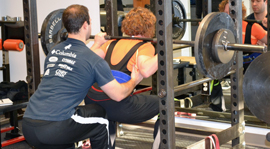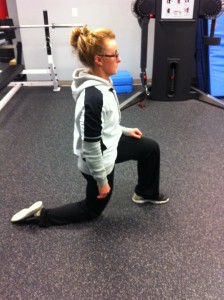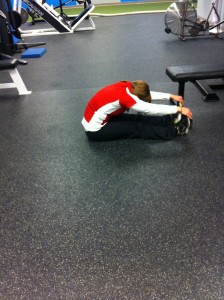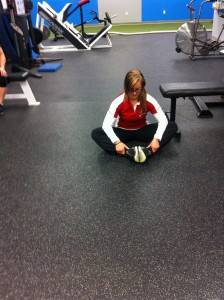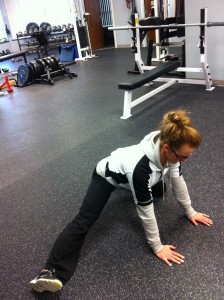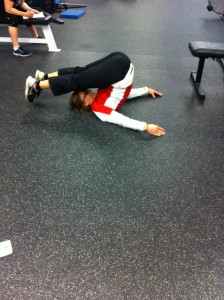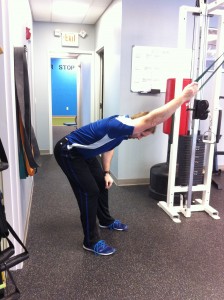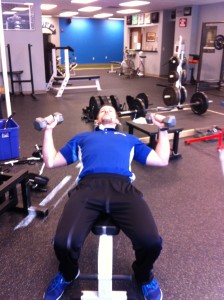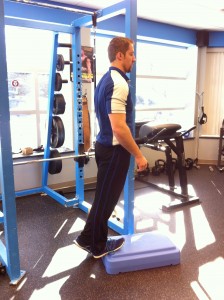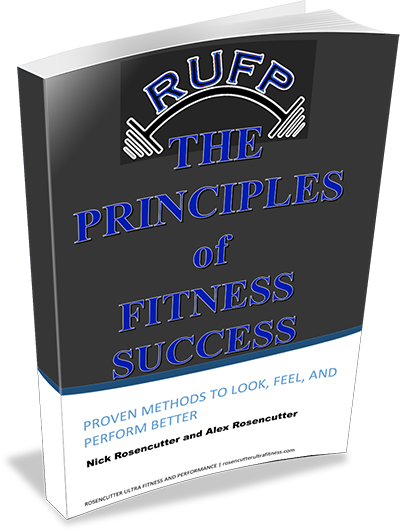Breathing with Fox 6 Studio A
Nick Rosencutter went on to Fox 6’s Studio A program last Wednesday to discuss breathing and show some effective breathing exercises to help with holiday stress.
“Between wrapping gifts and traveling to see relatives, the holidays can be stressful. Sometimes, you just need to breathe — and you might be doing that wrong. Nick Rosencutter, owner of Rosencutter Ultra Fitness & Performance, joined the Studio A team with some assistance.”
Check out the full video HERE.
Improved Breathing, Improved Human
Out of all of the things that people talk about with training and movement, breathing mechanics are one of the most important and most overlooked aspects. Breathing runs our body. Knowing this, it should be pretty easy to understand that if breathing mechanics are off, there will be compensatory problems. Faulty breathing mechanics can affect positioning, movement, pain signaling, nervous system state, blood ph levels, oxygen delivery, sleep patterns, anxiety, performance and the list goes on. Bottom line is breathing is kind of a big deal. Yet, while there are some very good fitness, rehab and related health professionals who are doing some great things with it, the vast majority in these related fields don’t even begin to think about looking at it. This is a problem and a mistake and is very unfortunate for their clients.
What is Breathing All About?
In a nutshell, breathing occurs with the purpose of taking in oxygen and expelling carbon dioxide so that we can live and go about our lives. Without it we would die. The diaphragm is our primary muscle of respiration. We then have accessory muscles that help the diaphragm to do its job by moving the ribs in various ways with each breath. These include the scalenes up in the neck, the intercostals between the ribs and the serratus posterior superior and inferior in the upper and lower back respectively, to name a few. The diaphragm essentially blows up like a balloon and moves down as we inhale and moves back up and “deflates” as we exhale while the various accessory muscles assist in moving the ribs with each breath. In an ideal world, our pelvis and ribs are lined up appropriately so that our diaphragm can grab on how it needs to and our ribs expand in the front, sides and back from the abdominal region all the way up into the chest. For many people, this does not occur because of various compensations and poor postural positioning. This leads to many problems as mentioned above.
Common Breathing Faults
1. Rib Flare and Low Back Extension
When we inhale, we want our ribs to expand all around our trunk like a balloon. Many people miss the boat and breathe only into the front as their ribs flare up and their low back extends. Though it may be subtle, when this occurs thousands of times a day, the low back and upper chest, shoulder and neck muscles that overwork when this happens become angry, inflamed and often painful. When done for a long enough period of time, this will usually show up in resting posture.
2. Excessive Rib Elevation
This can often occur along with the flare and extension from fault 1 but sometimes occurs on its own so we’ll talk about it separately. Rather than expanding the chest walls like we want, many people will simply elevate their ribs straight up in a shrugging type motion. The scalenes mentioned earlier along with the upper traps, levator scapulae and sternocleidomastoid muscles often overwork to raise the ribs up all day and get angry because of it, often leading to neck pain and headaches. They begin to act as primary breathing muscles instead of accessory breathing muscles. This is often called “chest breathing” by laypeople.
3. Poor Apical Expansion (especially right side)
As mentioned in the previous fault, many people do not get optimal expansion of their chest walls (apical expansion). This tends to be especially common on the right due to the position of our heart and our liver. With our liver towards the right and our heart towards the left, we tend to hang over our right sides, causing our right shoulders to sit lower than our left. Furthermore, our left hemi diaphragm pushes air to the right chest wall while our right hemi diaphragm pushes air to the left chest wall. Our right hemi diaphragm is apposed by the liver and the heart so it is able to push air easier than the left hemi diaphragm, which doesn’t have much to appose and help push the air. Because of this, our right upper ribs tend to get stuck in a “deflated” state. When we don’t get good apical expansion here, the elevation that was mentioned earlier sets in and the right scalenes, scm, etc. tend to take up the slack. This affects shoulder motion (often a lack of internal rotation) and head/neck mechanics. Its a big deal yet often completely overlooked.
There are also plenty of people who don’t fill either chest wall very well and get all belly motion. Remember, we want rib expansion all over the map, not just the belly. And pay attention to the fact that I said chest EXPANSION, not chest elevation, which is what occurs with the common “chest breathing” fault that is more commonly known. The Postural Restoration Institute has done a lot of great work on these apical expansion patterns.
4. Paradoxical Breathing
This type of breathing is an interesting occurence. This occurs when the belly moves in on the inhale and out on the exhale, the reverse of what should occur. If you’ve ever been to a group exercise or dance class with a “coach” or “instructor” who told you to “suck and tuck,” then this could be you (different thing but often related). This method of breathing will significantly decrease the deep and superficial stability all around your trunk and hips and can lead to a multitude of problems.
When we look at our “core” or our trunk and hips, we have deep stabilizers and superficial stabilizers. The superficial stabilizers are the ones that most people are usually talking about when they say “core.” You know, the abZ. Your rectus abdominis aka the 6 pack muscle and your external and internal obliques. If you’re lucky, low back muscles such as the erectors might even be mentioned in the convo. These guys are great and have their purpose; however, the deep stabilizers or the deep “core” need to be working properly first and need to be working harmoniously under the superficial players. The thoracic diaphragm, the pelvic floor muscles and the transversus abdominis are some major ones that need to be functioning properly.
The diaphragm attaches to the ribs, the spine and the central tendon and plays a role in both stabilization of the spine and ribs as well as a role in respiration. Ideally, we want our abdominals to brace and stabilize appropriately so that our diaphragm can focus more on respiration. We also want our diaphragm and our pelvic floor muscles to move and work together harmoniously for optimal stability, control and function. The folks at the Postural Restoration Institute go as far as calling the pelvic floor the pelvic diaphragm and the diaphragm the thoracic diaphragm, since they are so interrelated. When someone moves their belly in on the inhale and out on the exhale, this harmony is not there and stability suffers.
Looking aside at the relationship between the diaphragm and abdominals, with the “suck and tuck” method, more properly known as “hollowing,” (pulling your belly button towards your spine/sucking in your stomach) you effectively turn off the abdominal brace, making yourself unstable. Hollowing was proposed to activate the transverse abominis in isolation (which makes no sense with any exertional activity). Because of this hindering of the brace, the diaphragm then needs to turn some of its focus off of breathing and act more as a stabilizer. Guess what this leads to? Poor stability, poor respiration and oxygen delivery, poor movement, injuries and pain and the list goes on. Stuart McGill has done a lot of research comparing hollowing and abdominal bracing and makes a great point in his book “Ultimate Back Fitness & Performance:”
“Hollowing is an attempt to simply activate transverse abdominis in isolation, while bracing is simply contracting all muscles in the abdominal wall without drawing in or pushing out.” (P.120)
“Bracing appears to be a highly efficient strategy to enhance stability.” (P. 121)
“Finally, hollowing is weakening of the abdominal muscles as it can only be done when the abdominal muscles are almost inactive.” (P. 121)
That last point should resignate with you greatly if nothing else does. Don’t believe it? Try this. Lay on your back and bring your knees to your chest. Try hollowing/sucking in your stomach and straighten your legs while lowering them to the floor. Now that you feel how weak that is, brace your abs (harden them against your finger like you are about to get punched) and do the same thing. It is not even a question of which way is stronger. Try to lift anything heavy or exert yourself at all and this should happen almost automatically. The reason I’ve gone slightly off path of straight breathing is the fact that this abdominal function works so closely with breathing and the diaphragm, as mentioned above. Is there a time and a place for hollowing? With a specific rehab protocol for a specific reason, there absolutely may be. For performance, in my experience and opinion, I do not see it but if someone has a specific reason for it, then power to them.
When the paradoxical style of breathing and the suck n tuck style of poor abdominal function becomes habit, excess tension is often stored throughout the body since the diaphragm never really fully relaxes between the shallow breaths that occur since it is overactive as a stabilizer. If you feel like you constantly need to hold your breath when you are engaging in physical activity (or maybe even at rest) then this is probably describing you. This then leads to our sympathetic nervous system becoming overactive and we get stuck in fight or flight mode. This can then lead to faulty ph levels, inflammation, pain, anxiety, poor sleep, poor recovery and the list goes on. This problem can occur with the other breathing faults mentioned above as well, and these faults are often combined. This paradoxical pattern just seems to be closely related with this stability vs respiration problem. So next time you have an instructor or coach who instructs you to suck and tuck and/or breathe in this manner, I strongly encourage you to ask WHY?
5. Overbreathing
All of these situations tend to lead to a hyperventilatory state of overbreathing, where more carbon dioxide is let out than normal. Think “panic state.” According to Leon Chaitow and Judith Delany in their book “Clinical Application of Neuromuscular Techniques,”
“People who overbreathe, or who have marked breathing pattern disorders automatically exhale more CO2 than is appropriate for their current metabolic needs. Exhaled CO2 derives from carbonic acid in the bloodstream, and an excessive reduction of this leads to a situation known as respiratory alkalosis, where the pH of the blood becomes more alkaline than its normal of ~7.4.” (P.31-32) They go on to talk about the fact that the increased alkalinity causes more oxygen to stay binded to hemoglobin, which then leads to reductions in calcium and phosphate levels as well as intracellular magnesium, which all leads to many undesirable things such as increased sympathetic arousal, increased sense of apprehension and anxiety, reduced pain thresholds, fatigue, trigger points, compromised core stability and loss of balance among others. “Loss of CO2 ions from neurons stimulates neuronal activity, causing increased sensory and motor discharges, muscular tension and spasm, speeding of spinal reflexes, heightened perception and other sensory disturbances. Muscles affected in this way inevitably become prone to fatigue, altered function, cramp and trigger point evolution.” (P. 32)
Bottom line and moral of the story is: Breathing affects A LOT of things. If you are not addressing it, you are missing out and probably allowing many annoying problems to continue being problems without realizing it.
Ok, so what SHOULD we do?
Generally speaking, when we practice breathing, when we inhale it should be through our nose and when we exhale it should be through our mouth. This encourages proper mechanics and movement. Inhaling through the mouth encourages excessive accessory muscle usage and is usually related to faulty breathing mechanics. When we inhale, we should get good expansion around the front, sides and back from our abdominal cavity all the way up into the chest. When we exhale, our ribs should move down and we should blow all of the air out through our mouths like we are blowing up a balloon.(Use a balloon to train it with if you really wanna get good) This allows us to get all of the tension out of our system and lets our diaphragm fully lengthen and relax so that it can then recoil and shorten/contract more effectively to give us a deeper and better inhalation. It can also help calm down excessive low back tone and get us out of the oh so common extended state. It can calm down our sympathetic nervous system, calm down pain, help us sleep and so many other things. Learn to EXHALE. Once you do this, you will be able to inhale better which will then lead to better movement, better recovery, better stability, better tissue quality, better sleep and the list goes on.
Taking things a step farther, with general physical activity we should be able to breathe effectively with our diaphragm while our abdominals do their job stabilizing. There are plenty of effective ways to train this.
If we are talking about something such as a power lift like a squat or deadlift, then we want to get full inhalation, keep the air in and use this to help increase the stability around the abdominal wall until we exhale to finish the concentric portion of the lift. (So yes, the diaphragm SHOULD use its stabilizing capabilities in some instances).
There are many exercises and drills that can be used to effectively train breathing. Check out our youtube page or come visit us to learn more. You can also find many great ones from the Postural Restoration Institute. Below is a great one to get you started.
The moral of the story is breathing is a big deal. It affects everything with your body. If you are not addressing it with your training, you are missing out big time.

The Road to 600
Check out Nick’s guest article for Robertson Training Systems all about what he did to get his deadlift over 600 pounds. Give it a read HERE.
Troubleshooting the Lunge: How to Fix Your Form
Check out Nick’s latest article and video on STACK about proper front to back weight distribution with the lunge. You can get to it HERE. Check it out and comment here with any questions or thoughts. Enjoy!
Do You Even Healthy Recipe?
Today, we have a great article by our coach Dan Zwirlein. While healthy recipes can be great if used in the right manner, there are often many more important underlying things to take care of with people’s dietary habits. Sure, you had a gluten free healthy cookie, but does that really matter when the rest of your diet and habits are under par? Read on to find out!!
……………………………………………………………………………………………………………………………
The other day I was cooking dinner- I was making one of those meals in my “rotation”. You know, one of your go to meals that you eat all the time. I stopped to think if what I was making would constitute as a “healthy” recipe like those that are peddled all over the internet. You know, the ones on skinnymeals.com or whatever it is. I got really scared that it wasn’t, so naturally I came to the conclusion that, “wow I think healthy recipes are really stupid,” which is the general reaction that you get when you don’t understand something; however, as I was eating I thought some more about “what is a healthy recipe?” Does this mean its low calorie? Does it mean it contains vegetables? Does it mean paleo? Low carb? Gluten free? (People with celiac don’t get upset) I am still unsure and if I am unsure then certainly others are. This is a sign that it’s just making things unnecessarily more complicated.
Maybe it’s because I like to be a contrarian but I finally came to the conclusion that this whole healthy recipe sharing thing is kind of silly.
First, I think we can agree that there is no consensus on what is good or bad, healthy or unhealthy all of the time. Anything can be argued for in the right context, for the right person, at the right time, with the right goal. Second, nothing is inherently good or bad for the reasons above, which I’ve talked about in previous posts.
Here is the issue:
When these recipes make the rounds, they most certainly are marketed towards people looking to lose weight. This isn’t the problem. I mean I love new recipes, they are like opening a new jar of protein and having the scoop sitting on top. The problem is that most people, specifically people whose goal is to lose weight, don’t need a “healthy” recipe, they need an entire diet overhaul. If getting recipes to people was the problem there wouldn’t be an obesity issue. The problem is people putting the cart before the horse, meaning most people need to establish habits and consistency first before they get worried about making the quinoa salad, the “no guilt” greek yogurt pie, or buying the gluten/guilt free cookies.
The problem is we have a limited amount of brain power and focus to allot to tasks over the course of the day so it makes no sense to me to use it for having to go to the store and pick out special ingredients because you want to try that new healthy dessert/salad/extra gluten free noodle bake when said person is completely missing the point, which is the fact that they need to establish good consistent habits. It’s trying to use tactics to solve a philosophical problem. It’s like stepping over dollars to pick up pennies. Yeah you used greek yogurt instead of sour cream but who cares if the rest of your diet sucks.
What should you do?
You should focus on establishing healthy habits and principles first like keeping portion sizes in check and getting protein and fruit/vegetables at every meal, drinking enough water, etc. By establishing habits first you do a few things: Get on track with a consistent diet ( i.e. eating a lot of the same things), you better understand how many calories you are actually eating and you establish a baseline to add foods to. If you develop these habits first and for a long period of time, (at least 6 months), then you can explore some recipes that might intrigue you. If your habits are in check, along with your portion sizes, you can also just enjoy foods that actually taste good without having to pretend that your quest bar, ”healthy” peanut butter, or frozen yogurt are worthy imitations. Sounds easy enough, sounds intuitive, sounds like common sense but why don’t people focus on habits? Because they take work, it’s boring, it’s not flashy. It’s easier to make some new fancy meals than to focus on behavior and consistency.
Take Home
People need to think does this meal/recipe fit with my energy balance (calorie intake)? Does it fit with in my macro nutrient goals (fat, protein, carbohydrate) for the day? Did I eat enough vegetables today? Did I drink enough water? Make it easier on yourself first before adding complexity, which means eating the same foods over and over again then getting fancy. Ask yourself these questions and then decide for yourself, do you even need to healthy recipe?
Amplify the Slow Twitch
When it comes to skeletal muscle, our bodies contain different types of muscle fibers. Generally speaking, there are slow twitch and fast twitch fibers. Slow twitch are more geared towards endurance and low force activities like a marathon run while fast twitch are more geared towards fast, high powered, high force and shorter duration activities like a sprint. Different muscles throughout the body will generally be composed of more of one than the other. Furthermore, different people will genetically have more of one than the other.
While fast twitch can technically be divided to multiple different subsets, the two main subsets agreed upon by most are type a and b; with type a known as fast twitch oxidative. Fast twitch oxidative fibers have some good potential for good force and power output while still having the capability to assist with endurance activities. Through specific training, we can manipulate them to develop their oxidative potential to a certain extent. (or manipulate them the other way if that is the goal). By developing this oxidative potential in the weight room, these fibers can benefit an endurance athlete to a greater extent outside of the weight room. In addition to this, while most endurance athletes seem to grasp the concept that slow twitch fibers are utilized heavily with their runs or their bike rides, many don’t realize that they can be developed and trained in the weight room. How do we do this? The answer is Tempo Lifting.
While there is more than one way to do this, I will discuss a method we have been using with a former elite long track speed skater now turned competitive cyclist. I took a lot of this specific programming idea from sports scientist legend Yuri Verkhoshansky and his “Special Strength Training Manual for Coaches” and adapted it how I needed to for the task at hand.
Using the Yoke Squat as our main exercise, we will do the following for the first and key part of the training session on one day in the current programming phase.
In 1 series, he’ll hit a set of 15 to 20 slow tempo squats (currently 3 seconds down and 3 seconds up) to tap into his slow twitch fibers and get some hypertrophy out of them, followed by a set of 20 to 25 explosive squats to tap into his fast twitch oxidative fibers in order to prepare his body for the pace changes that can occur in a race. This is done for 3 series in his current program. There is 90 seconds rest between sets and 3 to 4 minutes rest between each series (of 2 sets). The weight for the explosive set is lighter than the slow tempo set.
To hit the oxidative fibers, we need enough resistance to require the body to utilize the fast twitch fibers (need to tap into their larger motor neuron) but also enough time with that resistance to tap into the oxidative side of things. The multiple series of the high reps with enough resistance and the explosive nature of the reps is a recipe to make this happen. So within these series we accomplish a few good things that are race specific:
1. We get some slow twitch hypertrophy (muscle growth) to help with their resiliance during the course of the race
2. We get some fast twitch oxidative development to help the slow twitch fibers on their journey and to help with the turbo boosters that will be needed at various points of the race
3. We train our bodies and muscle fibers to be more resiliant, stronger and more adapative to the tempo, intensity and pace changes that will inevitably occur through different stages of an actual race.
He follows this up with prowler pushes used in a similar manner. Trip 1 is slower paced followed up immediately by Trip 2 at a sprint pace. This is done for 5 to 6 sets. This is then followed by different accessory exercises such as glute ham raises and static inverted row holds.
His other lifting day in the program is focused on max strength and speed strength, which are also very important to any endurance race enthusiast though also often overlooked. He then has multiple bike days where we will develop specific energy systems and their subsets depending on the stage we are in leading up to the race. We can cover more on these other qualities in another article.
The goals for this article are to make you aware that we can develop and train slow twitch and the oxidative capability of type a fast twitch fibers in the weight room to help performance in that next race. Check out the videos below of Liam hitting his squat sets.
Tempo Squats

Explosive/Fast Twitch Oxidative Squats

Are you getting the most out of your race performance? Train with a purpose!
Note: It is essential that you have a decent strength training base built up before diving into something like this. You should know how to squat with proper movement/form and should have a decent level of general strength built up. Also, Liam is an elite athlete and can handle the workload and volume discussed. Those at a lower training level might not need as much. This is where the individual coaching comes into play 🙂
Interview on BalancedAmes
Check out Nick’s recent interview he did on BalancedAmes.com, a great blog about the body and life balance. He covers multiple topics ranging from advice for beginning exercisers and females starting out with strength work to his own weekly training plan. Give it a read HERE
Do You Really Need to Stretch? Part Three- Butchering edition
If you did not already read part one and two, do so before going through this post. In part three, here are some stretches that are either done incorrectly (but can be done in a good way) or are just plain bad altogether. Read on!
Hip flexor stretch: While there is a correct way to do a version of this one and a time to do it, this way is definitely not correct. By driving the hips so far forward and hyperextending the low back, you are simultaneously crushing the lumbar vertebrae and discs, and damaging the ligaments in the front of the hip. Both things that you don’t want to do (trust me, you really don’t). We want the pelvis and ribs to be stacked in good alignment with the thigh perpendicular to the floor.
Better option:
Here is the correct way to do it if needed. Though nowadays I often find that restoring proper breathing mechanics along with a little posterior tilt of the pelvis takes care of most of the tension that people have built up in their hip flexors, this can be beneficial to help get the glutes engaged along with some inhibition of the opposing hip flexors if they remain a problem. Notice how the thigh is perpendicular to the floor and her ribs and pelvis are stacked now, compared to the faulty position above. The glute on the down leg and the abs should both be engaged to assist with the stretch.
Sit and reach stretch: By letting the pelvis tilt and going into excessive lumbar flexion with tension, you are damaging the ligaments at the back of the pelvis and lower spine. Instabilities in the lower back are not fun and you definitely don’t want to create them by doing this. There are some very effective drills that do promote a healthy lumbar flexion for those who are stuck in extension.
Better option:
This 4 point breathing drill will give you the spine flexion that may be needed in a unharmful manner along with some good breathing to help calm down back tissues that have been stuck in extension. It can also help relax the hamstrings if they have been tensioned up to a faulty pelvic position (as mentioned in part one and two). Tuck the pelvis under (posteriorly tilt) and push away from the floor so that the back is rounded. You should feel the abs engage. Inhale through the nose and feel your back “expand” as you get air in. Hold the position as you exhale through your mouth
Hyperextension stretch: Similar to the “hip flexor” stretch mentioned above, this stretch wreaks havoc on the lumbar spine. Do I really need to explain after looking at this horrific picture? Most people are stuck in extension to begin with and if for some reason they did need some, this is definitely not the way to do it.
Better option: Umm, just don’t do it 🙂
Seated Adductor stretch: Your knee ligaments don’t like this one. ‘Nuff said.
Better option:
Should your adductor (s) need opening, use this adductor mobe stretch as its much safer on your knees and also has better effects through the hips. Although, we usually use this as a dynamic mobilization, this position can be held for time as well. Notice how her back is in a neutral position as she sits back into her hips with her right leg relaxed out to the side.
Foot to head stretch: Common theme: The passive structures of the low back do not like this. I put this on here because I used to see people do this at a gym I used to work at and it drove me nuts. If you are doing something similar as part of a backward roll drill, thats one thing but simply torquing yourself here is going to cause more problems than you want.
Better option: Try the 4 point breathing drill mentioned above if some restoration of spinal flexion is what you are after.
Avoid these body and ligament hating stretches and you will thank yourself. If not today, maybe tomorrow or a few years down the road. Train hard and train smart. Hope you enjoyed the series.
-Nick
Do You Really Need to Stretch? Part Two
Today, we have part two of our stretching series. If you didn’t already do so, please check out part one. Enjoy!
Flexibility can be overrated
Obviously, having a healthy range of motion in different areas of the body is a good thing. But its just that: a healthy range of motion. Having too little OR too much can be problematic. Example: If I have 80 to 90 degrees of straight leg hip flexion, my range of motion is healthy. If I have 20 degrees, I should probably get some length there so I don’t kill myself when I take a step. At the same time, if I have 160 degrees, I’m probably going to have some serious instabilities that are going to cause even worse problems. Excessive flexibility is usually not a good thing (instabilities that lead to pain, injuries, etc.) and instability is often harder to improve than stiffness or shortness. Those in the excessive flexibility category need to develop STABILITY to help their performance and prevent injury, NOT more stretching.
What does static flexibility even mean?
On this same subject, just because I have a decent range of motion in a static posture does not mean that it will carry over to actual active activity. When I hold a static stretch passively, I am causing inhibition of the muscle I am stretching with no real activation of any opposing or synergistic muscle and have no stabilization or control requirements. When I move my body during physical activity, I need certain muscles to kick in and stabilize while certain muscles activate and others inhibit. If I don’t have development of this multi faceted control, all of the static flexibility in the world won’t matter. This is one reason why dynamic stretching is much more effective before activity and static stretching should be saved for post activity (IF needed). It is also a good reason why strength training with proper squatting, hinging, pushing, pulling and rotation movement actually builds healthy mobility throughout the body contrary to the old myth that it makes you “stiff.” As an example, if you are squatting with good technique, you are building mobility through the hips, ankles, knees and thoracic spine WHILE simultaneously developing great core stability, strength, positive neurological firing patterns and total body control. You are developing strength through motion while certain muscles stabilize, certain muscles move and certain muscles learn to relax. Call me crazy but developing adequate mobility with a functional exercise like a squat seems like a much more rational idea than laying on a floor holding a static stretch that might give me some range of motion in that one position but does none of the other oh so important things just mentioned. Simply statically stretching one muscle without doing something to develop control or activity with another corresponding muscle is just not going to help me in most cases, period.
Just like having strength with a lack of mobility is not usually good, having flexibility without stability, strength or control can be even worse. More flexibility is not always better. This can be relative. If you are a dancer, gymnast, figure skater, cheerleader, etc. then you are most definitely going to need more than the normal healthy range of motion for most areas of the body; however, this must also come with plenty of control and stability. If you are a sprinter or speed skater, your hamstrings and hip flexion might be a little “stiffer” than normal because you utilize the stretch reflex and the “springiness” that the stiffness gives you to make you faster. Bottom line is: Have healthy mobility with adequate stability and control; if your sport requires more or less, then address this accordingly.
What stretches are good if I actually need them?
If something truly needs to be stretched (and its not often), then do it and make sure you do it right. Since most of you are going to stretch regardless of what you read, here are some that may actually be helpful for you. For the pecs (all those desk workers out there), I like Dumbbell fly eqi’s. For the calves (all those high heel girls out there), I like a basic hanging calf stretch off of a step. For lats, I like overhead band traction. For adductors (often the right) and left posterior hip (often the left), the Postural Restoration Institute has some nice stretches that are effective when needed. Do these for long durations along with good breathing to get the tissue to respond. Combine them with tissue therapy when needed to make it more effective and make sure you activate the appropriate muscle to help hold the new tissue length: strengthen the mid and low traps to help balance out the pecs, strengthen the anterior tibialis and extensors to balance out the calves and strengthen the low traps and possibly upper traps to balance out the lats. These are very basic and generalized examples and there is usually a lot more that will go into the specifics of what you need as an individual (i.e. left pec and right lat might be short on their respective sides so there will be some rotational and breathing components that will need to be addressed among other things) but at least start thinking along these lines. Bottom line is: Don’t just stretch blindly; have a reason.
Overhead band traction:
Keep back neutral, hinge down through hips and let arm move overhead while keeping some tension in the band (anchored to something above you). Take deep breaths while you hold the position for 60 sec to 2 minutes +. Do not force the arm higher than it can comfortably go.
Db Fly EQI
This is an active yet static stretch. Your pecs are in a lengthened position but are still contracting while in that lengthened position since you are holding the weight of the dumbbells. This causes the pecs to add sarcomeres (part of a muscle fiber) in that lengthened position which is very effective at lengthening these muscles and opening up closed down shoulder postures.
Build up from 20sec to up to 2 minutes and be sure not to go down too far
Calf Stretch- Find a stair or step, stand on the ball of your foot and let your heel hang down until you feel a stretch in your calf. Hold for 60 sec to 2 minutes plus.
All can be held for long durations once you are ready.
Think about it
Well that’s great Nick, but my Shape magazine and my elementary school gym teacher always made us stretch everything and its helped me a lot! How do you know its helped you a lot? Have you been tested or assessed? How do you know overstretching that left hammy didn’t contribute to your knee injury you suffered at age 13? How do you know you wouldn’t be stronger and move better if you did things differently? Just because someone once said stretching was the cool thing to do, everybody did it. Its kind of like the backwards food pyramid that recommends boatloads of breads and cereals every day and has probably contributed to many of the health problems that we have today. Don’t rely on conventional wisdom to take care of your body. Look at the facts, learn from those who are actually studying and working with this stuff and think for yourself. You just might improve your performance more than you think possible.
In an extra Part 3, we will show you some of the most common stretches that are performed, butchered and harmful. Stay tuned!
